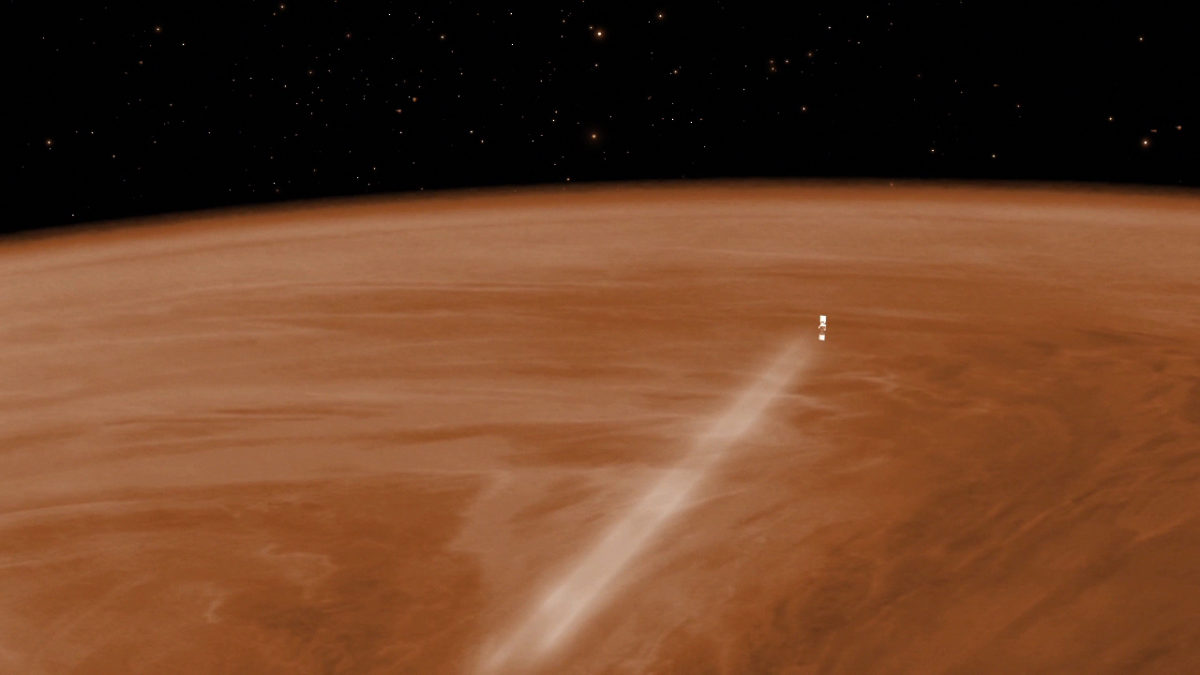Emily Lakdawalla • May 16, 2014
Venus Express science mission ends; aerobraking experiment beginning
Venus Express, currently the only spacecraft orbiting our nearest planetary neighbor, will soon meet a fiery end in Venus' atmosphere. According to a press release from the European Space Agency today, its science mission has ended. But its work isn't over yet. Just as NASA did with the Magellan Venus orbiter, ESA will maneuver Venus Express to dip into the uppermost Venus atmosphere and study how the spacecraft responds to atmospheric pressure. The work will give ESA valuable experience in aerobraking, in which the atmosphere of a planet like Venus or Mars is used to slow and shrink the orbit of a spacecraft -- saving fuel weight and making smaller, circular orbits possible.
Venus Express aerobraking video Visualization of the Venus Express aerobraking maneuver, which will see the spacecraft orbiting Venus at an altitude of around 130 kilometers from June 18 to July 11, 2014. In the month before, the altitude will gradually be reduced from around 200 km to 130 km. If the spacecraft survives and fuel permits, the elevation of the orbit will be raised back up to approximately 450 km, allowing operations to continue for a further few months. Eventually, however, the spacecraft will plunge back into the atmosphere and the mission will end.
Soon after -- or perhaps even during -- the aerobraking experiment, Venus Express will burn up in Venus' atmosphere, bringing the highly productive mission to an end.

The press release contained a few details about how the aerobraking phase of the mission will proceed:
Now, after eight years in orbit, the fuel supplies necessary to maintain the elliptical orbit are running low and will soon be exhausted. Thus, routine science operations concluded this week, and the spacecraft is being prepared for one final mission: to make a controlled plunge deeper into the atmosphere than ever before attempted.
“We have performed previous short ‘aerodrag’ campaigns where we’ve skimmed the thin upper layers of the atmosphere at about 165 km, but we want to go deeper, perhaps as deep as 130 km, maybe even lower,” says Patrick Martin, Venus Express mission manager.
“It is only by carrying out daring operations like these that we can gain new insights, not only about usually inaccessible regions of the planet’s atmosphere, but also how the spacecraft and its components respond to such a hostile environment.”
This ‘experimental aerobraking’ phase is planned for 18 June – 11 July, during which time some limited science measurements with the spacecraft’s magnetic field, solar wind and atom analysing instruments will be possible. Also, temperature and pressure sensors will record the conditions that the spacecraft is experiencing.
“The campaign also provides the opportunity to develop and practise the critical operations techniques required for aerobraking, an experience that will be precious for the preparation of future planetary missions that may require it operationally,” says Paolo Ferri, head of mission operations.
Aerobraking can be used as a way of getting into orbit around planets without having to carry quite so much fuel, thus reducing the launch mass.
It is possible that the remaining fuel in Venus Express will be exhausted during this phase or that the spacecraft does not survive these risky operations. But if the spacecraft is still healthy afterwards, its orbit will be raised again and limited operations will continue for several more months, fuel permitting.
However, by the end of the year, it is likely that Venus Express will have made its final descent into the atmosphere of the planet, bringing a fantastic scientific endeavour to an end.
This is the good kind of way for a space mission to end: having survived many times longer than expected, to the point of exhausted resources, and as a last act, performing an experiment that will open up new possibilities for ESA to deliver even more capable spacecraft to Venus and Mars. Based in part on the Magellan experience, NASA was able to use aerobraking successfully to circularize the orbits of Mars Global Surveyor, 2001 Mars Odyssey, and Mars Reconnaissance Orbiter, enabling missions that would not have been possible without the technique; I hope we see the same for ESA. So really, the only sadness I feel about Venus Express' coming end is that it will leave Venus without any Earth spacecraft. Akatsuki is on its way around the Sun, hopefully to arrive at Venus in late 2015 or 2016; but that mission is flying on a wing and a prayer. There has been no American mission to Venus since Magellan, and no Russian mission since the Vega missions. It's time we planned to return.

Let’s Go Beyond The Horizon
Every success in space exploration is the result of the community of space enthusiasts, like you, who believe it is important. You can help usher in the next great era of space exploration with your gift today.
Donate Today

 Explore Worlds
Explore Worlds Find Life
Find Life Defend Earth
Defend Earth

